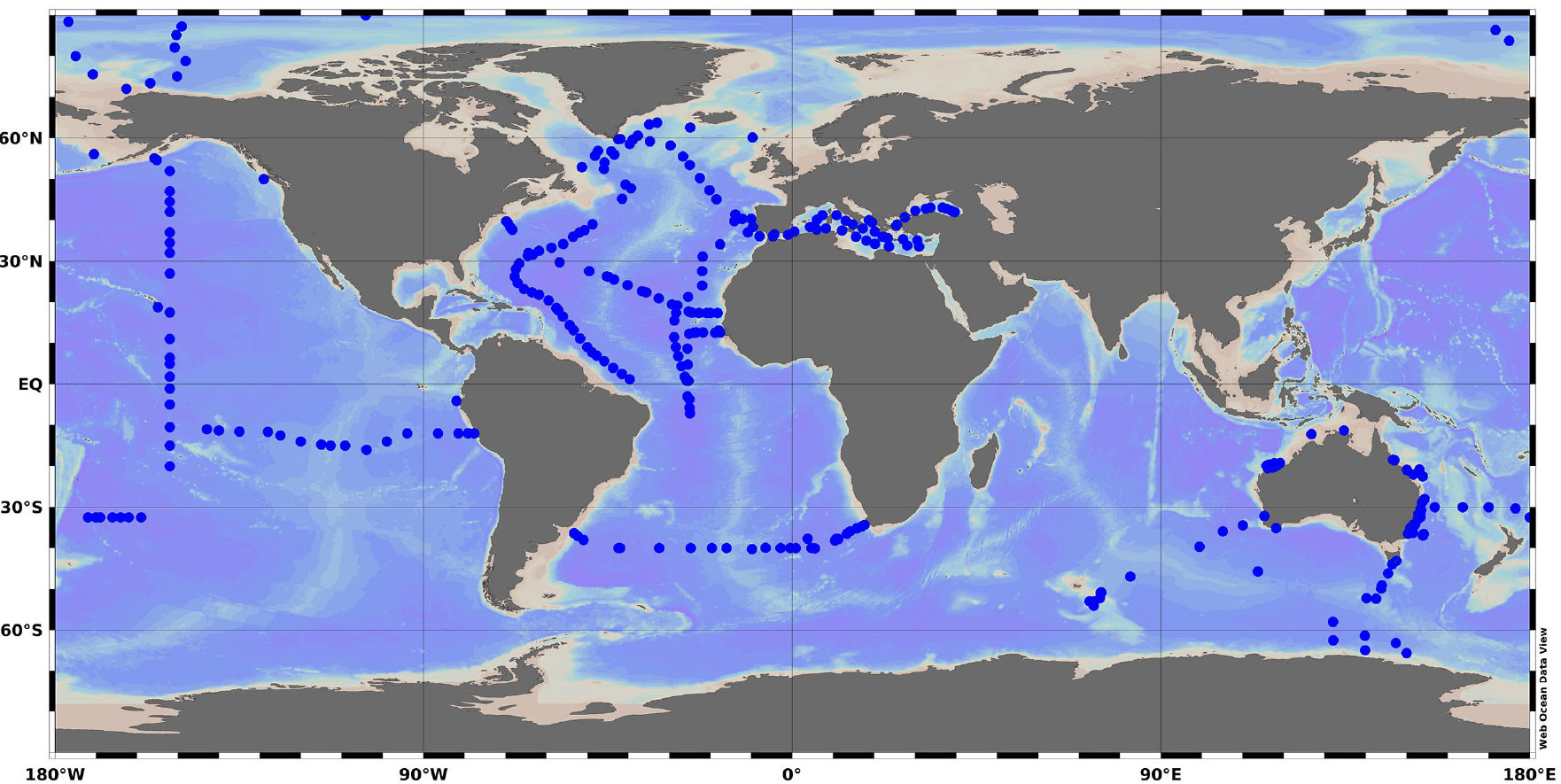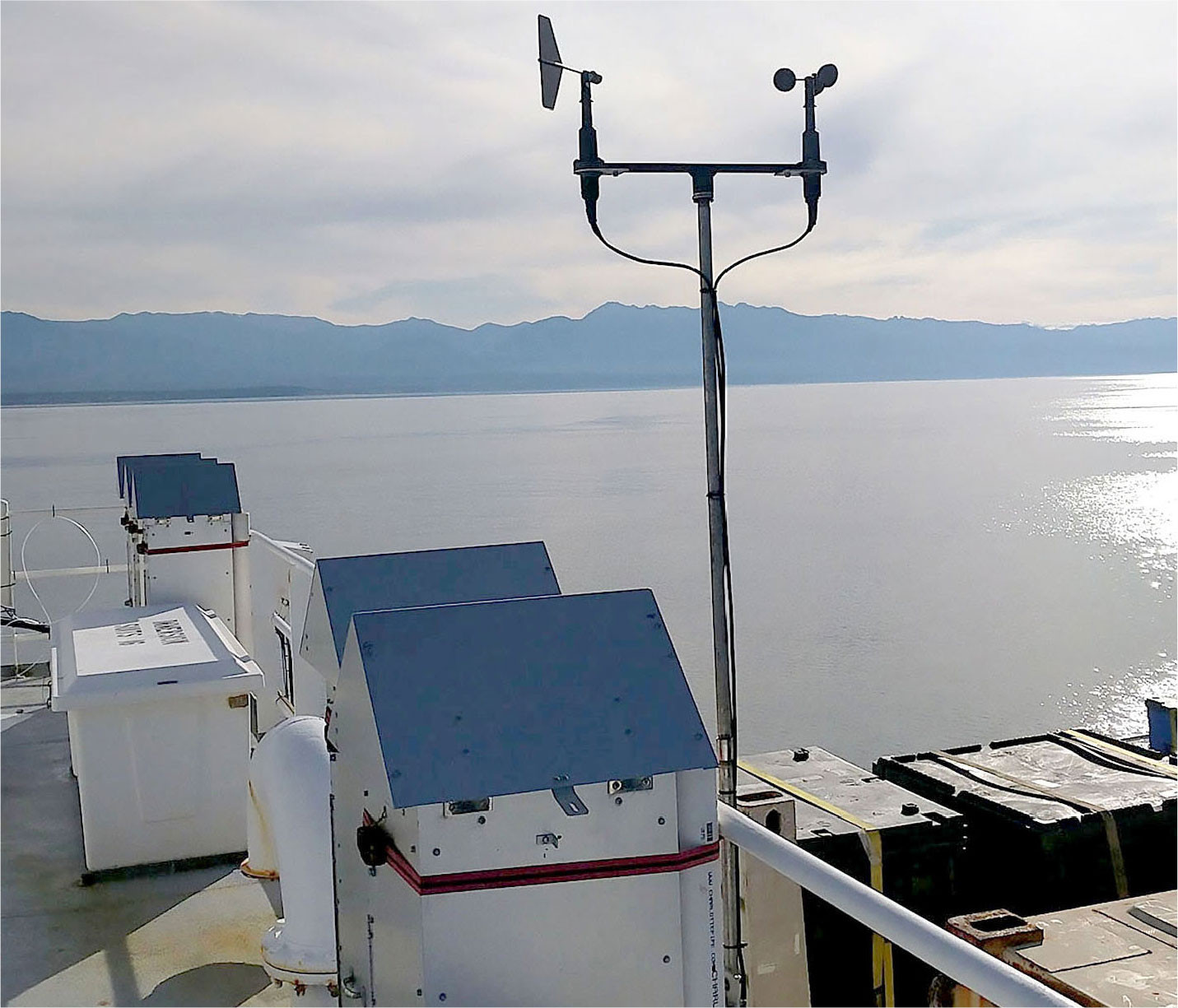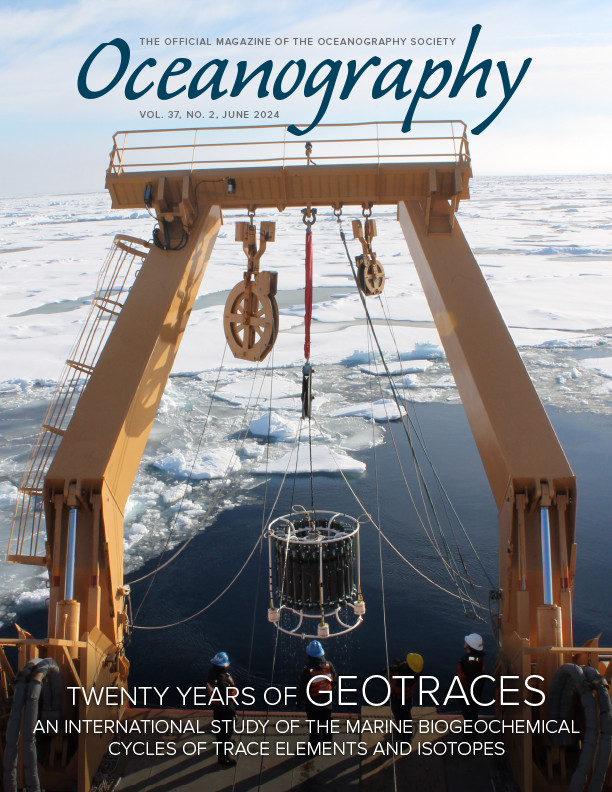Introduction
From the outset, the mission of the international GEOTRACES program has included efforts to better understand the role of micronutrients in marine ecosystems as well as the transport and fate of contaminants (SCOR Working Group, 2007). One primary research theme has been to quantify the fluxes that control the distributions of key trace elements and isotopes (TEIs) in the marine environment. In remote regions, far from other major sources, aerosol deposition can be the primary source of soluble, and potentially bioavailable, TEIs to surface waters where their input may impact biological primary production. For example, TEIs such as iron, manganese, zinc, copper, and nickel can influence phytoplankton community structure in the surface water and material cycling in the water column. In addition, excess concentrations of anthropogenic contaminant TEIs like lead and cadmium are used as tracers of anthropogenic emissions, and metals that are mainly sourced from Earth’s crust, such as aluminum, titanium, and thorium, may be used as tracers of lithogenic material. The study of aerosol TEIs is therefore essential in order to better understand specific processes and mechanisms in the ocean; hence, their inclusion as “key parameters” to be measured on all GEOTRACES research cruises.
Expansion of Global Coverage and Data Archives
By design, GEOTRACES brought discipline-focused research to central ocean basins and provided unprecedented access for coincident sampling of the water column and atmosphere. Following predecessors like the US CLIVAR section cruises (e.g., Buck et al., 2010, 2013) and the repeat Atlantic Meridional Transects (e.g., Baker et al., 2006), GEOTRACES has provided a means to greatly expand the spatial scale of aerosol sampling. Since the 2008 aerosol trace element intercomparison effort (Morton et al., 2013), 16 GEOTRACES research projects, including section cruises and some process studies, have reported aerosol datasets, and an additional 13 studies collected aerosols but have yet to make the data available. Combined, these programs have sampled all the world’s ocean basins, including the understudied regions of the central Arctic Ocean and South Pacific Ocean. Most of these individual research projects have made aerosol data available through online data repositories. A smaller subset has provided data for the open access GEOTRACES Intermediate Data Products (Figure 1; Schlitzer and Mieruch-Schnülle, 2024, in this issue) through the GEOTRACES Data Assembly Center, a process that requires high standards of data quality control and evaluation by the GEOTRACES Committee on Standards & Intercalibration (Aguilar-Islas et al., 2024, in this issue).

FIGURE 1. Blue circles indicate aerosol sampling locations whose data are available in version 2 of the GEOTRACES Intermediate Data Product (GEOTRACES Intermediate Data Product Group, 2023). > High res figure
|
Standardization of Sampling Equipment and Analytical Techniques
GEOTRACES is a coordinated study that involves research groups in different parts of the world, and many of the target parameters are assessed by new and developing analytical techniques. Thus, community agreement on best practices and standard procedures for sampling, sample processing, and analysis is necessary to reduce introduced variability and ensure the highest quality data.
Aerosol loading and composition can vary according to characteristics of the sampling site (e.g., distance to and type of local and surrounding sources, altitude if a land-based site, meteorological conditions) as well as processes occurring during particle transport. Additional variability comes from the various collection and sample processing techniques in use. As with water-column parameters, GEOTRACES has spurred the aerosol community to critically assess sampling and analytical protocols. Prior to this effort, aerosol collections were made with a variety of equipment, including both low-volume and high-volume active samplers, passive collectors, and total suspended or size-fractionated particle samplers. The choice of collection substrate, often a membrane filter, is yet another variable. A wide range of laboratory and sampling protocols in use resulted in datasets that are not readily intercomparable. Recognizing the importance of intercomparable data in global efforts, the community set out best practices for aerosol TEI sampling and sample handling in the “GEOTRACES Cookbook.” This resource is freely available online (https://www.geotraces.org/methods-cookbook/) and is regularly revised to reflect methodological advances in the field. Descriptions of aerosol extraction methods widely used in the community are also included.
By its nature, GEOTRACES ensured that ships from many nations and with different configurations would serve as observational platforms during program-endorsed research expeditions. Therefore, researchers sought a common sampling system that would be adaptable. The ideal system would be commercially available and not require extensive modification so that a broad swath of the research community could acquire the necessary equipment. Total suspended particle collectors were recommended because they met the desired criteria and have been used in both land-based and ship-based atmospheric sampling programs. These high-volume samplers feature a relatively small footprint, brushless motors, and are self-contained. The sampling interface and vacuum pump are co-located within an aluminum housing that can be mounted to the forward railings of ships (Figure 2). The collector is designed for bulk collections or can accommodate a cascade impactor for particle size fractionation. In addition to agreements on sampling practices, guidance on analysis of total TEI content in aerosols was provided following the aforementioned GEOTRACES-led intercomparison study effort (Morton et al., 2013). For example, similar total aeolian TEI determination protocols are now typically applied worldwide using nitric and hydrofluoric acids and heat to digest aerosol-laden filters.

FIGURE 2. Total suspended particle samplers are shown mounted on the forward railing next to the sector-control anemometer aboard R/V Roger Revelle during US GEOTRACES section cruise GP15. > High res figure
|
Not all aerosol metals reaching surface waters are assimilable by marine phytoplankton. Assessment of the soluble content in aerosols is therefore crucial for GEOTRACES water-column studies, as it is a proxy for the readily bioavailable fraction of aerosol TEIs. Constraining the soluble aerosol fraction remains a major challenge hindering our understanding of air-sea biogeochemical interactions. Laboratory methods used to assess the soluble aerosols typically consist of conducting leaching experiments on aerosol-loaded filters. Currently, many leaching protocols, using various solutions and extraction techniques, are employed to represent different atmospheric processes or types of deposition (Perron et al., 2020). However, data resulting from the different techniques are used as analogs in modeling studies. Hence, intercalibration is necessary to reduce the associated uncertainty. The Scientific Committee on Oceanic Research Working Group 167 (Reducing Uncertainty in Soluble aerosol Trace Element Deposition) is leading the synthesis effort and promoting best practices for intercomparable data on TEI bioavailability, including recommending broad use of community consensus reference materials that are appropriate for aerosols in the marine environment.
Estimates of Aerosol Properties and Deposition Flux
A key aspect of aerosol research within the GEOTRACES framework is the quantification of TEI deposition fluxes to the surface ocean as a source of biolimiting nutrients. Understanding why, where, and when aerosol TEI concentrations are changing, due to climate change and other anthropogenic activities, is crucial for assessing the impact of atmospheric deposition on society through consequences on ecosystem health, primary productivity, and global climate feedbacks, among other effects. Such understanding requires quantifying the properties of aerosols across different ocean basins and timescales. To fill this knowledge gap, GEOTRACES data, and data from other field programs, have been used to trace and constrain anthropogenic and natural sources of iron and other TEIs, and there have been important advances since the last progress report on TEI deposition research (Baker et al., 2016). For example, in recent years, a growing avenue of study has been the use of GEOTRACES data to identify variations in isotope fractionation of specific TEIs to differentiate aerosol sources of metals (e.g., Conway et al., 2019; Kurisu et al., 2021; Sieber et al., 2023). GEOTRACES data can then constrain atmospheric and oceanic modeling, thus improving projections of future patterns in aerosol nutrient and contaminant distributions.
Modeling studies have shown that uncertainty in the input fluxes of iron hampers efforts to build agreement on its residence time in ocean waters and thus the ability of models to accurately reproduce observations within the water column (Tagliabue et al., 2016). Long-used techniques, which apply a bulk deposition velocity estimate to convert observed atmospheric loading into a flux term, poorly constrain the magnitude of atmospheric deposition (Duce et al., 1991). Recent GEOTRACES efforts further indicated that deposition velocity estimates should also be region, particle size, and element specific. For example, aerosol iron concentrations and solubilities in size-fractionated aerosols collected in the North Pacific region originating from East Asia are significantly different from those collected in the North Atlantic region where aerosols mainly originate from North Africa, including the Saharan desert. Recent work shows that Atlantic aerosol iron on particles <1.0 μm (the fine fraction) has a fractional solubility less than about 5%, while the fractional solubility of iron on Pacific particles may be greater than 30% in the same size fraction (Baker et al., 2020; Hsieh et al., 2022). These studies use different methods to estimate fractional solubility, which complicates comparisons of the results (Perron et al., 2020). As summarized by Chance et al. (2015), non-lithogenic elements are often associated with smaller aerosol particles and are subject to lower deposition velocity estimates than are elements more associated with lithogenic material. Because aerosol deposition velocity and solubility are both highly dependent on particle size, deficient size-fractionated data and the corresponding metal solubilities could introduce significant bias in estimates of soluble aerosol deposition fluxes.
These estimates are also dependent on temporal snapshots of aerosol loading, which may miss seasonality in atmospheric deposition. GEOTRACES studies by their nature are short relative to seasonal and episodic aerosol transport and deposition events. To address this issue, GEOTRACES affiliated researchers have developed methods that leverage chemical tracers in the water column—in particular, radioisotopes like thorium-230, thorium-232, and beryllium-7—to produce flux estimates that are less reliant on snapshot observations of loading in the atmosphere (Anderson et al., 2016; Hayes et al., 2018; Kadko et al., 2015). Time-series atmospheric sampling stations located on coasts or islands are also powerful tools that can complement GEOTRACES work and provide information on longer-term variability in atmospheric emissions/deposition.
Acknowledgments
MMGP was supported by the Interdisciplinary graduate school for the blue planet (ISBlue, ANR-17-EURE-0015) in a project co-funded by the French government under the program “Investissements d’Avenir” embedded in France 2030. DSH gratefully acknowledges support from NASA (grant 80NSSC24K0446). The GEOTRACES 2021 Intermediate Data Product (IDP2021) represents an international collaboration and is endorsed by the Scientific Committee on Oceanic Research (SCOR). The many researchers and funding agencies responsible for the collection of data and quality control are thanked for their contributions to IDP2021.The international GEOTRACES program is possible in part thanks to the support from the US National Science Foundation (Grant OCE-2140395) to the Scientific Committee on Oceanic Research (SCOR).



